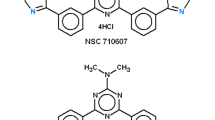Summary
CC-1065 was found to cause delayed toxicity at therapeutic doses, therefore, a large number of analogs have since been synthesized. A series of analogs with simplified but closely related structures were chosen for this investigation because some were found to be superior to CC-1065 in the treatment of several experimental tumors. The inhibition of L1210 cell growth by U-68,415 was comparable to that by CC-1065. A similar situation was true in terms of their in vivo potency; however, U-68,415 was superior to CC-1065 in terms of anti-P 388 leukemia activity. At the optimal dosage, U-68,415 produced 4 out of 6 long-term (> 30 day) survivors; whereas CC-1065 produced a mere 62% increase of life span (ILS) and no long-term survivors. The order of antitumor potency and effectiveness of the CC-1065 analogs was U-68,415 > U-66,694 > U-68,819 > U-66,664, which was parallel to the inhibition of L1210 cell growth. CC-1065 and all the analogs tested here inhibited DNA synthesis approximately 10 times more than RNA synthesis. Protein synthesis was the least inhibited. On a molar basis, U-68,415 was about 6–9 times more inhibitory toward cellular DNA synthesis than CC-1065, yet the interaction and/or binding of CC-1065 to DNA determined by circular dichroism, DNA melting or differential cytotoxicity assay was much stronger than that of U-68,415. The order of binding of these analogs to calf thymus DNA was U-68,415 > U-66,694 > U-68,819 > U-66,664, and was parallel to that of DNA synthesis inhibition which was in turn parallel to cell growth inhibition and antitumor potential. These results collectively suggest that the cellular DNA is a major site of the action of CC-1065 analogs; however, time course studies reveal that the inhibition of cellular DNA synthesis could not wholly account for their cytotoxicity. Hence, the precise mechanism of action of these agents is not yet fully understood. U-68,415, which exhibited superior activity against a number of tumors and did not cause delayed death in mice, warrants further investigation. U-68,415 is a racemate and two chiral isomers were recently isolated. Therefore, further investigation of both U-68,415 and its chiral isomers is necessary.
Similar content being viewed by others
References
Hanka LJ, Dietz A, Gerpheide SA, Kuentzel SL, Martin DG: CC-1065 (NSC-298223), a new antitumor antibiotic. J Antibiotics 31:1211–1217, 1978
Martin DG, Biles C, Gerpheide SA, Hanka LJ, Krueger WC, McGovren JP, Mizsak SA, Neil GL, Stewart JC, Visser J: CC-1065 (NSC-298233), a potent new antitumor agent-improved production and isolation, characterization and antitumor activity. J Antibiotics 34:1119–1125, 1981
Li LH, Swenson DH, Schpok SLF, Kuentzel SL, Dayton B, Krueger WC: CC-1065, a novel antitumor agent that interacts with strongly double-stranded DNA. Cancer Res 42: 999–1004, 1982
McGovren JP, Clarke GL, Pratt EA, DeKoning TF: Preliminary toxicity studies with the DNA binding antibiotic CC-1065. J Antibiotics 37: 63–70, 1984
Wierenga W: Synthesis of the left-hand segment of the antitumor agent CC-1065. J Amer Chem Soc 103:5621–5623, 1981
Warpehoski MA, Kelly RC, McGovren JP, Wierenga W: N-2-substituted tetrahydro-4-oxocyclopropa[c]pyrrolo- [3, 2-e]indoles: Novel anticancer agents modeled on CC-1065. Proc Am Assoc Cancer Res (Abstr) 26:221, 1985
Wierenga W, Bhuyan BK, Kelly RC, Krueger WC, Li LH, McGovren JP, Swenson DH, Warpehoski MA: Antitumor activity and biochemistry of novel analogs of the antibiotic, CC-1065. In: G. Weber (ed) Advances in Enzyme Regulation. Pergamon Press, Oxford, 1986, pp 141–155
Li LH, Kuentzel SL, Murch LL, Pschigoda LM, Krueger WC: Comparative biological and biochemical effects of nogalamycin and its analogs on L1210 leukemia. Cancer Res 39:4816–4822, 1979
Geran RI, Greenberg NH, MacDonald MM, Schumaker AM, Abbott BJ: Protocols for screening chemical agents and natural products against animal tumors and other biological systems. Cancer Chemother Rep Part 3 3:1–103, 1972
Krueger WC, Pschigoda LM: Circular dichroism calibration by Kramers-Kronig transform methods. Anal Chem 43:675–677, 1971
Hurley LH, Reynolds VL, Swenson DH, Petzold GL, Scahill TA: Reaction of the antitumor antibiotic CC-1065 with DNA: structure of a DNA adduct with DNA sequence specificity. Science 226:843–844, 1984
Warpehoski MA: Total synthesis of U-71,184, a potent new antitumor agent modeled CC-1065. Tetrahedron Lett 27:4103–4106, 1986
Author information
Authors and Affiliations
Rights and permissions
About this article
Cite this article
Li, L.H., Wallace, T.L., DeKoning, T.F. et al. Structure and activity relationship of several novel CC-1065 analogs. Invest New Drugs 5, 329–337 (1987). https://doi.org/10.1007/BF00169971
Issue Date:
DOI: https://doi.org/10.1007/BF00169971




